Full description
The Coral Sea is a critically important and environmentally significant ecosystem, which (like coral reefs globally) is increasingly threatened by changing environmental conditions, and especially, ocean warming. Extensive surveys were conducted throughout 2018 and 2019 across 18 reefs in the Coral Sea Marine Park (CSMP), extending from Boot Reef in the north (9.9o latitude) to Cato Reef in the south (23.2oS). This is the most extensive survey ever undertaken of shallow reef environments in the Coral Sea. Importantly, surveys were conducted at Ashmore and Boot Reefs in the far northern CSMP and at Mellish Reef, located east of the central CSMP, where there has been very limited prior research or monitoring of coral reef assemblages. These highly isolated reefs were notable standouts in terms of reef health. In particular, sharks were observed much more frequently and coral cover was generally higher at Ashmore, Boot and Mellish Reefs compared to other reefs throughout the CSMP.
Project summary: The principal output of this project will be providing spatial and temporal analyses of hydrodynamic patterns in the Coral Sea Marine Park (CSMP) to facilitate planning and establishment and/or revisions of existing management plans. This project will inform patterns of connectivity and circulation flow across the broader CSMP, and between CSMP and Great Barrier Reef Marine Park using existing modelling platforms.
Created: 2022-05-05
text: Coral Sea
User Contributed Tags
Login to tag this record with meaningful keywords to make it easier to discover
- DOI : 10.25903/PB1V-R198

- Local : researchdata.jcu.edu.au//published/f9717610cc0811ec96e79967aec3951f


